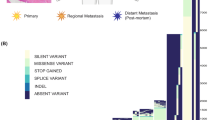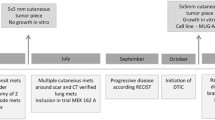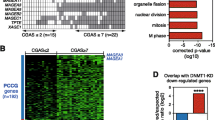Abstract
Recently, the tissue origin of MDA-MB-435 cell line has been the subject of considerable debate. In this study, we set out to determine whether MDA-MB-435-DTP cells shown to express melanoma-specific genes were identical to various other MDA-MB-435 cell stocks worldwide. CGH-microarray, genetic polymorphism genotyping, microsatellite fingerprint analysis and/or chromosomal number confirmed that the MDA-MB-435 cells maintained at the Lombardi Comprehensive Cancer Center (MDA-MB-435-LCC) are almost identical to the MDA-MB-435-DTP cells, and showed a very similar profile to those obtained from the same original source (MD Anderson Cancer Center) but maintained independently (MDA-MB-435-PMCC). Gene expression profile analysis confirmed common expression of genes among different MDA-MB-435-LCC cell stocks, and identified some unique gene products in MDA-MB-435-PMCC cells. RT-PCR analysis confirmed the expression of the melanoma marker tyrosinase across multiple MDA-MB-435 cell stocks. Collectively, our results show that the MDA-MB-435 cells used widely have identical origins to those that exhibit a melanoma-like gene expression signature, but exhibit a small degree of genotypic and phenotypic drift.
Similar content being viewed by others
References
Cailleau R, Olive M, Cruciger QV. Long-term human breastcarcinoma cell lines of metastatic origin: Preliminary characterization. In Vitro 1978; 14(11): 911–15.
Price JE, Polyzos A, Zhang RD, Daniels LM. Tumorigenicityand metastasis of human breast carcinoma cell lines in nudemice. Cancer Res 1990; 50(3): 717–21.
Price JE, Zhang RD. Studies of human breast cancer metastasisusing nude mice. Cancer Metast Rev 1990; 8(4): 285–97.
Clarke R, Leonessa F, Brunner N, Thompson EW. In vitromodels of human breast cancer. In Harris JR, Lippman ME, Morrow M, Hellman S (ed): Diseases of the Breast. Philadelphia: Lippincott, 1995.
Clarke R, Johnson M. Animal models. In Harris JR (ed): Diseases of the Breast, 2nd edition. Philadelphia: Lippincott Wil-liams & Wilkins; 2000; 319–34.
Ross DT, Scherf U, Eisen MB et al. Systematic variation ingene expression patterns in human cancer cell lines. Nat Genet2000; 24(3): 227–35.
Jessani N, Liu Y, Humphrey M, Cravatt BF. Enzyme activity pro-les of the secreted and membrane proteome that depict cancercell invasiveness. Proc Natl Acad Sci USA 2002; 99(16): 10335–40.
Lee H, Lin EC, Liu L, Smith JW. Gene expression pro ling oftumor xenografts: In vivo analysis of organ-specific metastasis. Int J Cancer 2003; 107(4): 528–34.
Ellison G, Klinowska T, Westwood RF et al. Further evidenceto support the melanocytic origin of MDA-MB-435. MolPathol 2002; 55(5): 294–99.
Myers TG, Anderson NL, Waltham M et al. A protein expres-sion database for the molecular pharmacology of cancer. Elec-trophoresis 1997; 18(3–4): 647–53.
Leonessa F, Green D, Licht T et al. MDA435/LCC6 andMDA435/LCC6MDR1: ascites models of human breast cancer. Br J Cancer 1996; 73(2): 154–61.
Scudiero DA, Monks A, Sausville EA. Cell line designationchange: Multidrug-resistant cell line in the NCI anticancerscreen. J Natl Cancer Inst 1998; 90(11): 862.
Ackland ML, Newgreen D, Price JT et al. Epidermal growthfactor stimulates epithelio-mesenchymal transition in the stablehuman breast carcinoma cell line variant PMC42-LA. LabInvest 2003; 83(3): 435–48.
Kallioniemi OP, Kallioniemi A, Piper J et al. Optimizing com-parative genomic hybridization for analysis of DNA sequencecopy number changes in solid tumors. Genes ChromosomesCancer 1994; 10(4): 231–43.
Eisen MB, Spellman PT, Brown PO, Botstein D. Cluster analy-sis and display of genome-wide expression patterns. Proc NatlAcad Sci USA. 1998; 95(25): 14863–68.
Takeo S, Arai H, Kusano N et al. Examination of onco-gene ampli cation by genomic DNA microarray in hepatocel-lular carcinomas: comparison with comparative genomichybridization analysis. Cancer Genet Cytogenet 2001; 130(2): 127–32.
Rae JM, Cordero KE, Scheys JO et al. Genotyping for polymor-phic drug metabolizing enzymes from para. In-embedded and im-munohistochemically stained tumor samples. Pharmacogenetics2003; 13(8): 501–507.
Davidson JM, Gorringe KL, Chin SF et al. Molecular cytoge-netic analysis of breast cancer cell lines. Br J Cancer 2000; 83(10): 1309–17.
Sellappan S, Grijalva R, Zhou X et al. Lineage in delity ofMDA-MB-435 cells: Expression of melanocyte proteins in abreast cancer cell line. Cancer Res 2004; 64(10): 3479–85.
Welch DR, Krizman DB, Nicolson GL. Multiple phenotypicdivergence of mammary adenocarcinoma cell clones. In vitro and in vivo properties. Clin Exp Metast 1984; 2(4): 333–355.
Welch DR, Evans DP, Tomasovic SP et al. Multiple phenotypicdivergence of mammary adenocarcinoma cell clones. II. Sensi-tivity to radiation, hyperthermia and FUdR. Clin Exp Metast1984; 2(4): 357–71.
Welch DR, Nicolson GL. Phenotypic drift and heterogeneity inresponse of metastatic mammary adenocarcinoma cell clones toadriamycin, 5-. uoro-2-deoxyuridine and methotrexate treatment in vitro. Clin Exp Metast 1983; 1(4): 317–25.
Welch DR, Milas L, Tomasovic SP, Nicolson GL. Heteroge-neous response and clonal drift of sensitivities of metastatic13762NF mammary adenocarcinoma clones to gamma-radia-tion in vitro. Cancer Res 1983; 43(1): 6–10.
Bahia H, Ashman JN, Cawkwell L et al. Karyotypic varia-tion between independently cultured strains of the cell lineMCF-7 identified by multicolourfluorescence in situ hybridization. Int J Oncol 2002; 20(3): 489–94.
Gilles C, Thompson EW. The epithelial to mesenchymal transi-tion and metastatic progression in carcinoma. The Breast J1996; 2: 83–96.
Thiery JP. Epithelial to mesenchymal transitions in tumour progression. Nat Cancer 2002; 2: 442–54.
Hendrix MJ, Seftor EA, Kirschmann DA, Seftor RE. Molecu-lar biology of breast cancer metastasis. Molecular expression ofvascular markers by aggressive breast cancer cells. BreastCancer Res 2000; 2(6): 417–22.
Satya-Prakash KL, Pathak S, Hsu TC et al. Cytogenetic analy-sis on eight human breast tumor cell lines: high frequencies of1q, 11q and HeLa-like marker chromosomes. Cancer Genet Cy-togenet 1981; 3(1): 61–73.
Price JE. Analyzing the metastatic phenotype. J Cell Biochem1994; 56(1): 16–22.
Thompson EW, Waltham M, Ramus SJ et al. LCC15-MBcells are MDA-MB-435: A review of misidenti ed breast andprostate cell lines. Clin Exp Metast 2004; 21(6): 535–41 (thisissue).
Ramus SJ, Pharoah PD, Harrington P et al. BRCA1/2 muta-tion status influences somatic genetic progression in inheritedand sporadic epithelial ovarian cancer cases. Cancer Res 2003; 63(2): 417–23.
Author information
Authors and Affiliations
Rights and permissions
About this article
Cite this article
Rae, J.M., Ramus, S.J., Waltham, M. et al. Common origins of MDA-MB-435 cells from various sources with those shown to have melonoma properties. Clin Exp Metastasis 21, 543–552 (2004). https://doi.org/10.1007/s10585-004-3759-1
Issue Date:
DOI: https://doi.org/10.1007/s10585-004-3759-1




